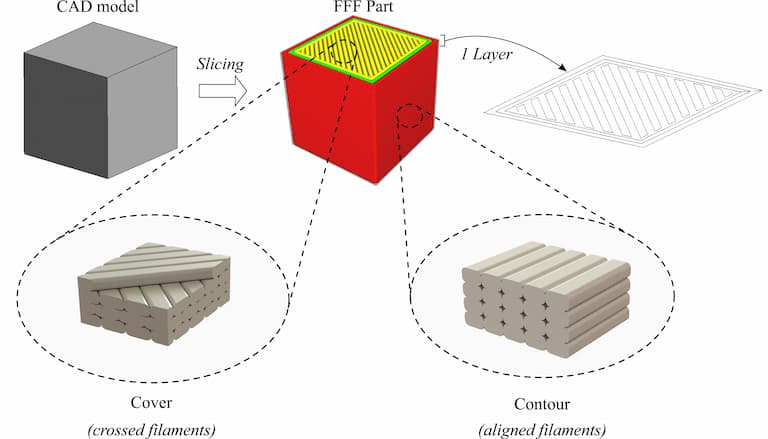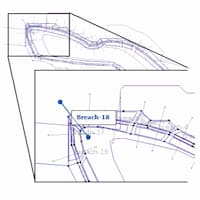news
CIMNE researchers develop new damage criterion for Additive Manufacturing
A group of four CIMNE researchers, led by Dr. Michele Chiumenti as senior author, have developed a new Mechanism-Based (MB) orthotropic damage criterion for Fused Filament Fabrication (FFF), a popular and affordable 3D printing technology of Additive Manufacturing that produces complex layered components.
In a paper entitled Mechanism-Based damage and failure of Fused Filament Fabrication components the researchers from CIMNE’s Industrial Manufacturing Processes RTD group used a Mechanism-Based (MB) damage material model to study the failure mechanics of FFF and developed a novel MB damage criterion considering damage driven by different failure modes.

3D printing scheme and printing patterns present in a FFF component.
In the manuscript, authors Iván Rivet and collegues, propose an MB cracking model that incorporates the orthotropic brittleness of FFF components and use experimental and numerical simulations to compare their criterion to that of Tsai–Wu (TW), which is commonly used for orthotropic materials.
According to the researchers, the results of the novel MB damage criterion outperform those of TW, and can accurately match experimental outcomes and predict the breaking mechanism even in complex 3D states.
In Iván Rivet’s words, this new model allows for “reduced-cost high-fidelity simulations of Additive Manufacturing components”, and will enable “a better understanding of their orthotropic mechanical properties and mixed failure modes”.
All the research has been developed in the International Centre for Numerical Methods in Engineering (CIMNE) by Iván Rivet (Conceptualization, Software, Writing, and Editing), Narges Dialami (Methodology, Validation, and Review), Miguel Cervera (Conceptualization, Supervision, and Review), and Michele Chiumenti (Conceptualization and Software).
The manuscript, which is already available online for a fee, will be published in the volume 270 of the Composites Part B: Engineering journal in February 2024.
Related items
-
23/07/2025Researchers at CIMNE’s Innovation Unit in Transport, CENIT, have begun working on a signif...
-
16/07/2025Jakarta took a step closer in its journey toward a more sustainable, breathable future in April, a...
-
Career Spotlight — Chiara Saragani: Applying Engineering Research to Optimize Maritime Supply Chains23/06/2025On this International Women in Engineering Day, we spotlight the work of Chiara Saragani, a research...
-
19/06/2025The International Centre for Numerical Methods in Engineering (CIMNE) is hosting a two-day hackathon...
-
06/05/2025In recent days, several articles have been written about the possible causes of the blackout that hi...
-
18/03/2025Article adapted from original article by Alex Mumbrú Camprubí and Genís Majoral...
-
04/03/2025By Clara Soler i Bañuelos In the coming years, public transport authorities will face unprec...
-
21/01/2025A novel study by researchers at CIMNE and the Port of Barcelona has developed an innovative framewor...
-
05/12/2024The FIBRE4YARDS project, coordinated by the International Centre for Numerical Methods in Engineerin...
-
26/11/2024Dealing with sustainable mobility challenges is no easy task: from technological barriers to physica...
-
13/11/2024CIMNE’s Innovation Unit in Transport, CENIT has released the Issue 3 of its magazine, Innovati...
-
23/10/2024CIMNE researchers last week presented two use cases for monitoring air quality in Barcelona and pred...
-
14/10/2024Photo: Myrabella / Wikimedia Commons / CC BY-SA 3.0 Around 3,000 maritime incidents occur every y...
-
07/10/2024Railway stations hold a unique position in the urban landscape: they not only act as complex nodes o...
-
02/10/2024Schools play a central role in urban spaces, often serving as a second home for children. But modern...
-
26/09/2024CIMNE’s innovation unit in transport, CENIT, is one of the more than 40 cross-cutting partners...
-
08/03/2024Researchers at CIMNE's Machine Learning in Civil Engineering Research Group and the Flumen Insti...
-
04/03/2024The International Centre for Numerical Methods in Engineering (CIMNE) has published a “one-sto...
-
20/02/2024Shipping container operators could move their long-haul Mediterranean hubs to Northern Africa to avoid the emissions tax, warn CIMNE experts
-
16/02/2024Dr. Pere-Andreu Ubach, from the Civil and Environmental Engineering research group at CIMNE, this we...






















